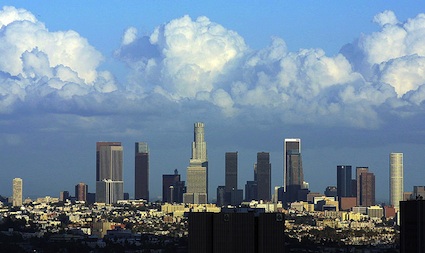Cool Roofing Materials in LA Could Reduce Air Pollution, Energy Costs

LOS ANGELES — Cool roofing material in Los Angeles could reduce air pollution and energy costs, according to a new report by the UCLA School of Law.
The law school’s Emmett Center on Climate Change and the Environment recommends the widespread use of cool roofing material to combat climate change in a city where hot summers result in severe air pollution and the resulting public health consequences, as well as energy blackouts, heat waves and other ills, according to the report.
Titled "Bright roofs, big city: Keeping L.A. cool through an aggressive cool-roof program," the Emmett Center’s second Anthony Pritzker Environmental Law and Policy Brief makes a case for speeding the adoption of cool roofs in the city and proposes law and policy strategies for achieving that goal.
The report states cool roofs make particular sense in Los Angeles because the city experiences mild winters and cool roofs can help the city reduce its energy costs, its peak energy demands and its reliance on coal-fired energy sources.
The report includes an outlined set of proposed policy changes, ranging from incentive payments from the Department of Water and Power rooftop conversions to a city ordinance that mandates the use of cool roofing material on new and replacement roof projects.
“Traditional roofing materials are typically dark in color and absorb heat, unnecessarily warming the buildings and neighborhoods they cover,” according to a statement from the university. “Cool roofs take advantage of roofing surfaces that reflect rather than absorb the sun’s energy, which helps keep buildings cooler and saves owners money that otherwise would have been spent on energy to cool the buildings.”
Los Angeles residents could save up to $30 million a year if the city significantly improved its adoption of cool roofs on new and existing buildings, according to Cara Horowitz, author of the report and the Andrew Sabin Family Foundation Executive Director of the Emmett Center.
"This estimate is conservative, based on saved energy costs alone,” she said. “It does not factor in additional sources of savings, such as avoided health care costs from reduced rates of asthma and fewer heat-related injuries and deaths."
When aggregated across a city, the benefits of cool roofs are event greater, according to the report.
Researchers at Lawrence Berkeley National Laboratory came to a similar conclusion, stating that by acting as mini-reflectors, the roofs help to cool the earth by reducing the amount of heat in the atmosphere to counteract the effects of climate change pollution.
"A switch to cool roofs in Los Angeles would provide a climate change benefit, cooling the atmosphere enough to offset the warming caused by nearly 40 million metric tons of emitted CO2, in some scenarios,” Horowitz said. “This is equivalent to about 80 percent of the city’s greenhouse gas emissions in a year, or the amount emitted by about 7 million cars on the road for a year. It would be as if Los Angeles got nearly a year’s free pass from emitting climate pollution."
